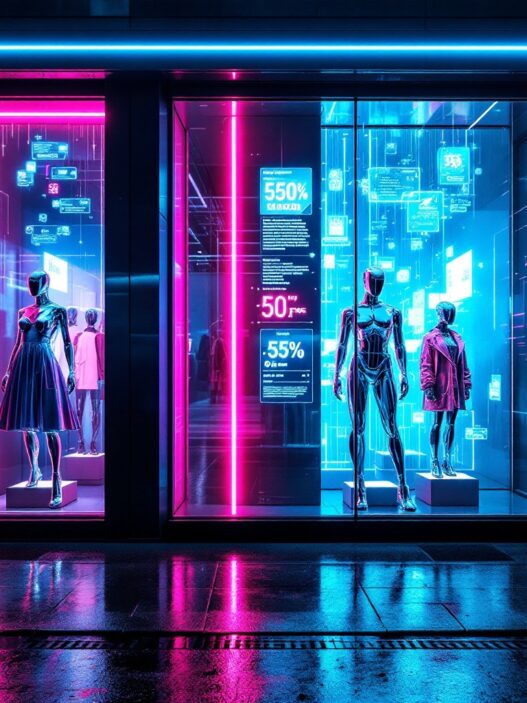Have you ever noticed how some fashion stores seem to know exactly what you want, even before you speak? That’s biometric technology at play. Biometric data technology is becoming increasingly prevalent across digital and retail sectors. Imagine stepping into a high-end showroom where a smart mirror scans your face and suggests new collections based on your biometric profile. It sounds futuristic, but it’s already happening. Many fashion brands appear to be collecting not just our feedback, but even our facial features, often without clearly informing us. This is primarily done to offer personalised product recommendations, and it involves technologies such as 3D facial scanning and virtual try-on tools. Brands are utilising these tools to enhance customer engagement and profits through innovations such as contactless payments, fingerprint scanners, and virtual fitting rooms. While these features enhance the shopping experience, they also bring up serious legal and ethical concerns.
What is Biometric data?
Biometric data is being used more than ever; however, the absence of a clear definition complicates efforts to regulate and safeguard this data. Its meaning often depends on the specific legal jurisdiction or authority involved. Broadly, biometrics refer to distinctive physiological and behavioural traits such as DNA, iris or retina scans, fingerprint patterns, facial geometry, vocal tone, or even body dimensions. Surprisingly, even something as small as how we speak, type, or the pressure we apply when signing can be considered biometric data. The core purpose of biometric technology lies in identification, verification, and personal convenience. According to the Biometric Data Institute, these technologies are mainly used for:
- Public safety and law enforcement (keeping us safe)
- Access control and personal convenience (simplifying everyday security)
- Workforce management, including uses in advertising, education, and operations
Application of Biometric Data in the Indian Context
- Information Technology (Reasonable Security Practices and Procedures and Sensitive Personal Data or Information) Rules, 2011
India is still in the process of shaping its legal framework around biometric data. This is particularly important as more retail brands begin incorporating such technologies into their day-to-day operations. The Information Technology (Reasonable Security Practices and Procedures and Sensitive Personal Data or Information) Rules, 2011, commonly referred to as the IT Rules 2011, classify biometric data as Sensitive Personal Data (SPD).
Rule 3 of these rules requires that organisations obtain explicit consent before collecting biometric data. They are obligated to disclose to the user what data is being collected, the reason for its collection and steps taken to secure it. However, many fashion retailers in India are now using augmented reality (AR) apps and smart mirrors that collect biometric data without offering proper disclosure or user-friendly consent mechanisms.
We are encountering this trend increasingly in apps and stores that offer:
- Virtual try-on mirrors
- Face-scanning cosmetics applications
- Body-scanning tools for size and fit recommendations
These tools often collect and process facial geometry or similar biometric inputs without providing clear information to users. From a legal standpoint, brands are required to:
- Notify users of the type and purpose of the data collected
- Obtain prior, explicit consent
- Securely store and protect the data
- Delete the data once its intended purpose is fulfilled
Failure to comply with these obligations may result in liability under Section 43A of the IT Act, 2000. It could also amount to a violation of the right to privacy, as recognised by the Supreme Court in the case of Justice K.S. Puttaswamy v. Union of India, wherein the Supreme Court declared privacy a fundamental right under Article 21.
- Digital Personal Data Protection Act, 2023 (DPDP Act)
India’s recently enacted Digital Personal Data Protection Act, 2023 (DPDP Act), provides a well-structured framework for protecting biometric data. The act is reinforced on three pillars: consent data processing, purchase limitation, and data minimisation. Given how closely facial scans and fingerprints are tied to an individual’s identity, their use must be transparent, necessary, and ethical.
- Personalised Shopping through Virtual Try-On Technology
Virtual Try-On Technology (VTOT) is now one of the most prominent uses of biometric data in fashion retail. It works through facial mapping, real-time image processing, and body scanning to help users try on clothes, eyewear, or cosmetics virtually. Popular Indian platforms, such as Nykaa, Lenskart, and Myntra, have introduced AR-based tools to enhance the customer experience.
While this technology reduces product returns and improves satisfaction, it also involves collecting sensitive biometric data, such as facial dimensions, often without well-defined consent protocols or data retention policies. Many users might reasonably wonder: Where does all that scanned data go? Under the DPDP Act, any such data processing must be preceded by free, informed, and specific consent standards that many apps do not yet fully meet.
- Targeted Marketing and Consumer Profiling Using Biometric Inputs
Some retailers now go a step further by adjusting advertisements based on facial expressions or moods, yes, really. Smart mirrors and interactive displays in cities like Mumbai, Delhi and Bangalore are already using these tools to tailor marketing based on perceived gender, age, or emotional state.
While the intent is to improve engagement, such practices blur the line between personalisation and surveillance. The most concerning aspect is that many users are unaware that their expressions and gaze are being tracked. The DPDP Act mandates transparency and restricts unnecessary data collection, but several biometric marketing tools in the retail space may fall short of these standards.
- Workforce Monitoring and Attendance Management
Biometric systems are not limited to customer experience; they’re also being used in workforce management. Retail employers are implementing fingerprint and facial recognition systems to monitor attendance and prevent issues like buddy punching.
Although the DPDP Act allows for deemed consent in employment scenarios, the lack of specific workplace data protection rules leaves employees vulnerable to excessive monitoring. To prevent privacy violations disguised as efficiency measures, organisations must implement ethical standards and clear internal policies.
Comparative Analysis: Indian vs. US Biometric Data Laws in Fashion Retail
So, how does India’s approach compare to that of the United States? As biometric technology becomes more embedded in retail through AI tools, virtual try-ons, and contactless interactions, the need for solid legal backing becomes clear.
India primarily relies on the IT Rules 2011 and the DPDP Act. These laws require informed consent, transparency, and data protection, but sector-specific enforcement remains weak. Although the Personal Data Protection Bill, 2019, aims to enhance oversight, it is still under consideration.
In contrast, the U.S. lacks a federal biometric law; however, some states have enacted robust laws. According to the California Consumer Privacy Act (CCPA) and the California Privacy Rights Act (CPRA), classified biometric data is considered personal information, granting individuals the right to access, delete, and limit its use.
Illinois has gone a step further. It is known for its strict requirements under the Biometric Information Privacy Act (BIPA), which mandates that businesses obtain written consent, state the purpose of data collection, and define data retention timelines. Importantly, individuals can sue companies for violations without needing to prove actual harm.
Compared to the stronger enforcement mechanisms in states like Illinois and California, India’s framework remains more flexible and is still in the process of development. This leaves Indian retailers vulnerable to both reputational damage and legal risks, particularly as consumer awareness and judicial scrutiny increase.
Conclusion
Fashion is evolving, and technology is at the heart of it. From virtual fitting rooms to smart mirrors and contactless checkouts, biometric innovations are revolutionising the shopping experience. But with this transformation comes the responsibility to protect personal data. While the DPDP Act is a welcome step, it still lacks detailed guidance specific to the fashion sector.
To truly balance innovation with individual rights, India needs a more precise and enforceable policy structure, one that keeps pace with the retail industry’s rapid growth. Without such clarity, biometric profiling risks crossing into ethically grey areas. For fashion to remain both forward-thinking and respectful, it must be as conscious of privacy as it is of style.


















